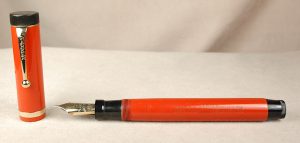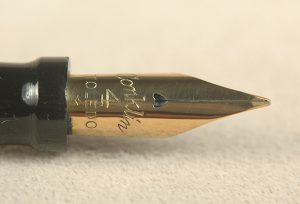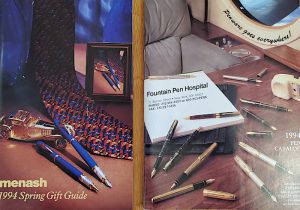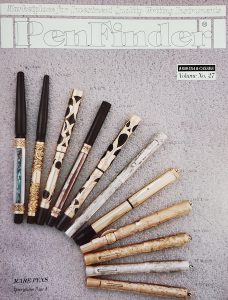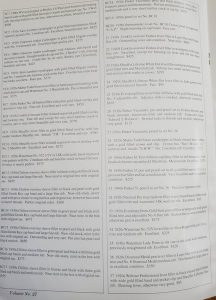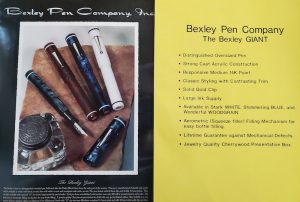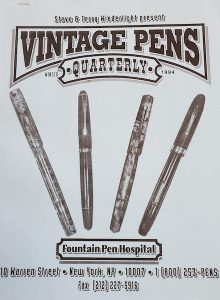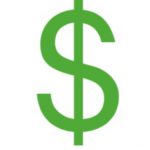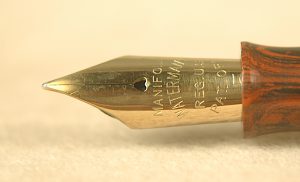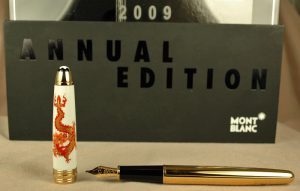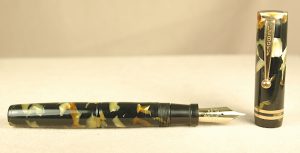A good friend recently asked me why some pens cost more than others. The cheeky, glib and true answer is supply and demand. But, it is more than that. Sometimes it is marketing. Sometimes its trends in the marketplace.
However, he was asking for something more specific. When looking at vintage pens, he saw wildly fluctuating prices for pens that looked almost the same to him. Why does the average super-famous senior Parker Duofold “Big Red” (orange) go for $100 or $200 and the average senior Parker Duofold in Mandarin Yellow go for $800 or $900?
Big Reds are pretty common, especially the later 1920s’ version made of “permanite.” Most vintage collections have several of these pens. Mandarin Yellow versions of the same pen are fairly rare. They didn’t make as many, and the material used to make the yellow turns very brittle with age. As such, a large percentage of the senior Mandarin Yellow Duofolds broke. Nevertheless, these are still beautiful pens, and their scarcity makes them all the more desirable. Senior-sized Duofolds cost the most back when they came out, so many people bought the smaller Junior and Lady Duofold models to save money. As such, collectors have chosen the rarer senior models to be the favorite, which is why junior and Lady Duofold versions of the pen in mandarin yellow sell for much less than the seniors.
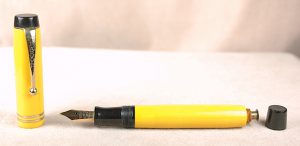
Mandarin yellow was a much more fragile substance to make Parker Duofolds, and it didn’t age well. These Mandarin Duofolds are much more sought after because they are more scarce.
This also is a good place to demonstrate trends in the marketplace, too. I am writing this in October of 2022. Where as a reasonable price to pay for a senior Mandarin Parker Duofold is $800 to $900, five to seven years ago, these same pens were getting $1,200 to $1,500. These pens were in higher demand back then, and dealers couldn’t keep them in stock. The market has softened some since then. Why? 2 factors. 1.) Just about everybody who wanted one of these pens back then got one if they could afford it. 2.) Sadly, we are starting to see a passing of a generation of vintage pen collectors. There are more and more of these pens on the market, and younger generations of pen users and collectors are not as excited about vintage pens. ALSO, the younger generation is paying off insanely large sums of college debt and paying tons more for skyrocketing housing prices. In their hierarchy of stuff to pay for, a rare 100-year-old pen is not as pressing as next month’s rent or feeding a young family.
Staying in the Parker Duofold family, Senior Big Reds made of orange hard rubber are usually much more valuable than the more common and less fragile “permanite.” Streamlined Senior Parker Duofolds are rarer and tend to get more than the “traditional” flat-top designs. Pristine Lapis (blue) Senior Duofolds can command a lot more money due to the fact most Lapis Duofolds turned dark and nearly black in some cases. The same goes for the Pearl and Black Duofolds. They turned brown with discoloration. If you find a pristine one, those are going to get a lot more money. Another feature on a Parker Duofold that is highly regarded is the bandless senior Parker Duofold Big Red. These pens are also really hard to find. Most Duofolds had one, two or even three bands near the lip of the cap. The bands help to protect the cap when posting it on the tail of the pen. Bandless models weren’t common, and the caps often broke when people posted them. Soooo, many people will pay top dollar for a bandless senior Duofold.
We haven’t even left the Parker Duofold family, yet.
Flexible nibs are king right now. Everybody wants one, and so few pens came with flexible nibs over the years. All flex nib pens command top dollar. Basic Waterman 52s would sell for maybe $50 ten to fifteen years ago. Yet, many of their tiny #2 nibs have a little to a lot of flex, and these same pens now get between $100 and $150.
Conversely, one of the several Waterman pens that really draw big bucks are early 1920s Waterman #7 Pink pens. These were oversized…or close to it…. The distinguishing feature of these pens is a pink ring around the top of the cap AND the word “Pink” imprinted on the 14k gold nib. Waterman made these nibs specifically to be very flexible writers. All of the color-ring Waterman #7’s are fairly desirable, but Pink is the most sought. As such, these pens command much more money. You can probably find a Waterman 56 or 58 in black hard rubber from the same general time period for less…with the same basic flex nib…and save a bundle over the Pink.
Apparently, even cheap TWISBI fountain pens made in China are falling down this pricing rabbit hole. You can buy most TWISBI Eco fountain pens for around $15 to $20 brand new. However, just the other day I saw a “limited edition” transparent orange cap TWISBI Eco sell at an auction for more than $230! It was a discontinued color that people love enough to get into a bidding war over.
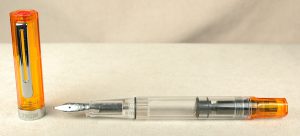
Most TWISBI Eco fountain pens are pretty inexpensive but this rare color model goes for more than $200 on some auctions sites.
There are probably hundreds of vintage pens (and modern) such as these to ask these questions of, and so I shall revisit this topic and question from time to time to help sort out why some pens are so much more valuable than others.


 Shopping Cart
Shopping Cart




